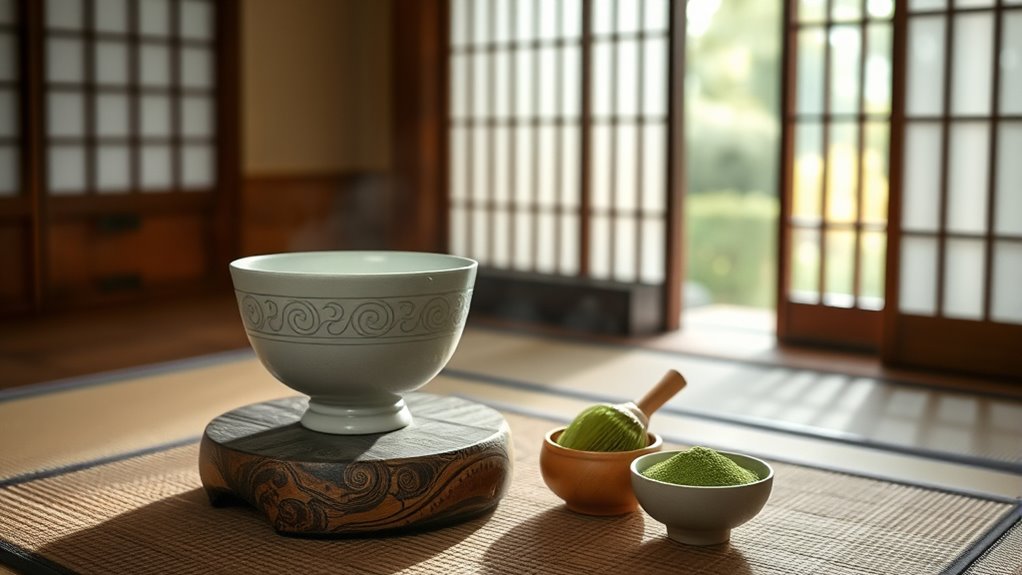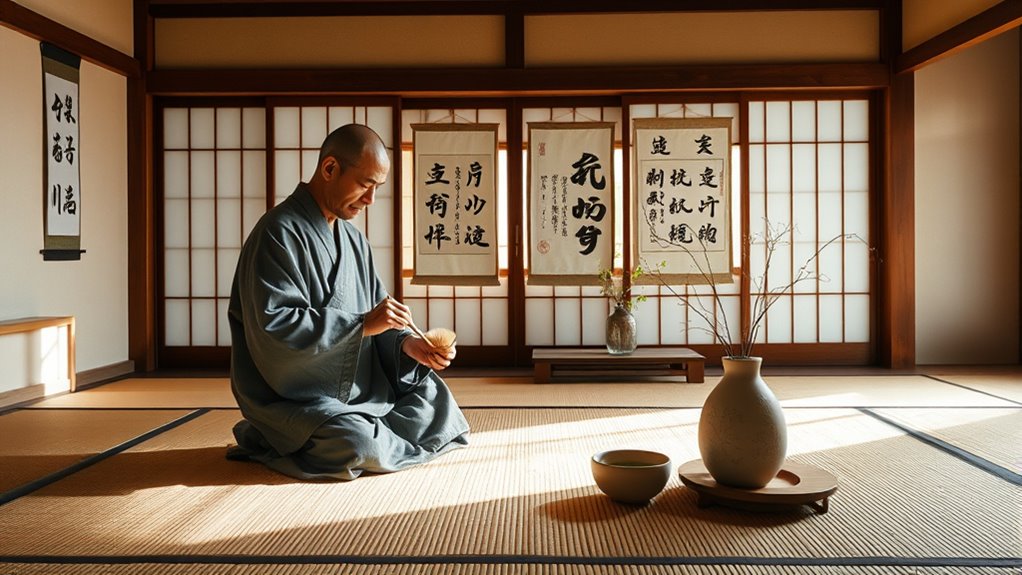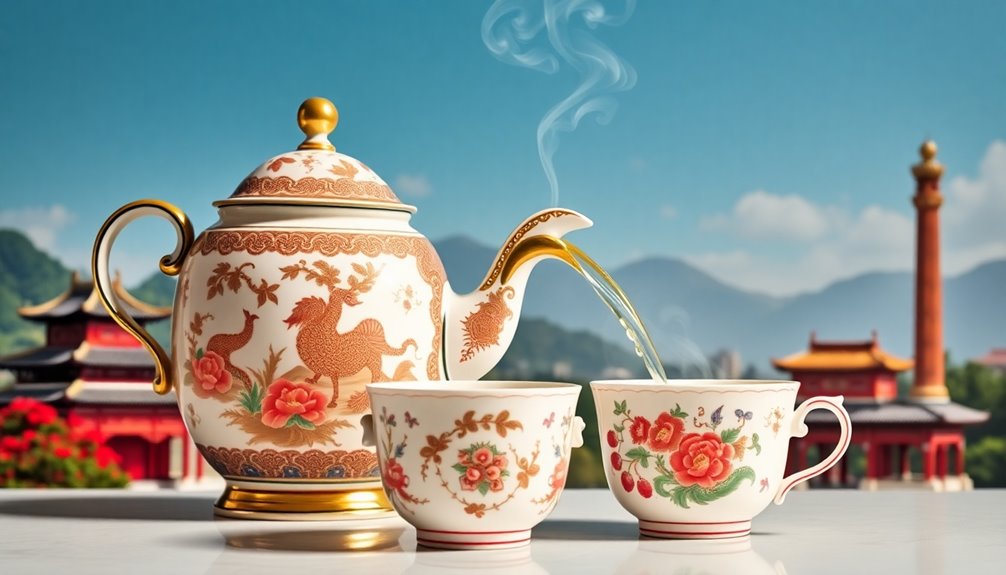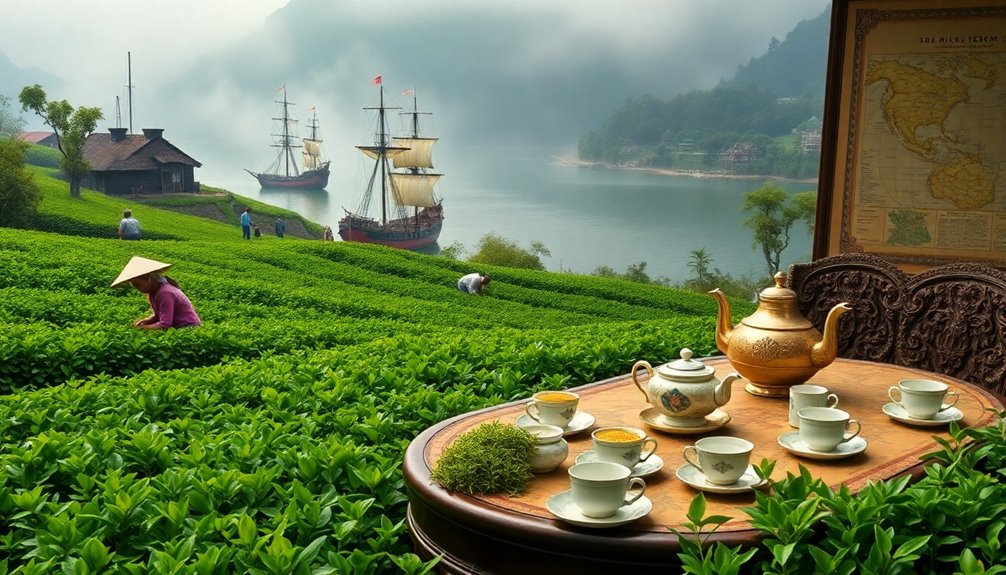In Zen monasteries, matcha’s ceremonial origins date back centuries, where monks used it to support meditation and spiritual growth. You’ll find that the ritual of preparing and drinking matcha emphasizes mindfulness, discipline, and respect. Every movement is deliberate, turning tea-making into a meditative act that fosters inner calm and awareness. If you continue exploring, you’ll discover how these traditions evolved into a meaningful practice that links mindfulness with everyday life.
Key Takeaways
- Matcha’s ceremonial use in Zen monasteries dates back centuries as a meditative practice.
- Monks used matcha to stay alert during long meditation sessions and spiritual rituals.
- The preparation process reflects Zen discipline, emphasizing mindfulness, precision, and calmness.
- Ritualized matcha consumption symbolizes humility, respect, and harmony central to Zen philosophy.
- Over time, it evolved into a sacred act that fosters spiritual growth and mental clarity within Zen tradition.

In Zen monasteries, ceremonial matcha plays a pivotal role in fostering mindfulness and spiritual discipline. When you participate in the tea ceremony, you engage in a mindful ritual that emphasizes presence, focus, and clarity. The process of tea preparation isn’t just about making a drink; it’s a meditative act that cultivates inner calm and discipline. Every movement, from whisking the powdered green tea to pouring the hot water, is deliberate and precise. This intentionality helps you develop a heightened awareness of each moment, reinforcing the core Zen principles of mindfulness. The origins of matcha in Zen monasteries trace back centuries, where monks used it as a tool for meditation and spiritual development. Consuming matcha became more than just a way to stay alert during long hours of practice; it evolved into a sacred act that aligns the mind and body. The preparation of the tea itself becomes a form of spiritual discipline, requiring patience, focus, and reverence. You learn to approach each step with care, understanding that the process mirrors the discipline needed in Zen practice—calm, attentive, and unwavering. This ritualistic approach transforms a simple act into a spiritual discipline that cultivates discipline, patience, and mindfulness.
During the ceremonial matcha, you’re encouraged to be fully present, observing the sensory details—the vibrant green color of the powder, the aroma of fresh tea leaves, the warmth of the bowl in your hands. This heightened awareness deepens your connection to the moment, helping you shed distractions and cultivate a sense of serenity. The repetitive, deliberate movements — scooping, whisking, pouring — reinforce the discipline necessary for spiritual growth in Zen practice. Through consistent tea preparation, you develop a sense of discipline that extends beyond the tea ceremony, influencing your daily life and mental clarity.
The ritual also embodies humility and respect, fundamental aspects of Zen philosophy. You approach each session with reverence, honoring the tradition and the mindfulness it promotes. The act of preparing and consuming matcha becomes a spiritual discipline that emphasizes simplicity, harmony, and focus. Over time, this practice helps you foster inner stability, patience, and a deeper understanding of yourself. The ceremony’s roots in Zen monasteries highlight how a simple cup of tea can serve as a powerful tool for spiritual cultivation, making each tea session a meaningful journey toward mindfulness and discipline.
Additionally, the integration of holistic approaches such as mindfulness and meditation techniques within the ceremony enhances its spiritual benefits.
Frequently Asked Questions
How Did Matcha’s Use Spread Beyond Japan’s Monasteries?
You might find that matcha’s use spread beyond Japan’s monasteries through the tea trade and cultural diffusion. As trade routes expanded, merchants and travelers introduced matcha to other countries, where it gained popularity for its unique flavor and health benefits. Cultural exchanges, especially in the 16th and 17th centuries, helped embed matcha into social and culinary traditions worldwide, transforming it from a sacred beverage into a global phenomenon.
Are There Specific Rituals Associated With Matcha Preparation in Zen?
Imagine the quiet dance of tea leaves, each step symbolizing harmony and mindfulness. In Zen, you follow specific rituals that embody this ritual symbolism, emphasizing reverence and focus. Tea etiquette guides your movements, turning preparation into a meditative act. Every gesture, from whisking to serving, reflects inner calm and respect, transforming simple matcha into a sacred ritual that cultivates serenity and spiritual connection.
What Are the Differences Between Ceremonial and Culinary Matcha?
You’ll notice that ceremonial matcha involves precise tea preparation, emphasizing mindfulness and traditional techniques that highlight its vibrant flavor profiles. In contrast, culinary matcha is more versatile, often incorporated into recipes where its earthy taste adds depth. While ceremonial matcha boasts a delicate, umami-rich flavor, culinary matcha tends to be stronger and more robust, designed to complement other ingredients rather than stand alone.
How Did Zen Philosophy Influence Matcha Drinking Customs?
Imagine discovering a ritual that deepens your meditative mindfulness and nurtures spiritual discipline. Zen philosophy shaped matcha drinking customs by emphasizing mindfulness and harmony, transforming tea into a sacred practice. When you partake in matcha, you’re embracing a mindful moment that fosters inner calm and connection, echoing Zen’s spiritual discipline. This tradition invites you to slow down, reflect, and honor the present, turning tea into a meditative experience.
Are There Modern Adaptations of Traditional Matcha Ceremonies?
You’ll find that modern cafes often adapt traditional matcha ceremonies into casual tea tastings or workshops, making the experience more accessible. Instead of strict rituals, these settings emphasize appreciation, mindfulness, and community. You might participate in matcha tastings, learning about different grades and flavors, or enjoy creative presentations like latte art. These adaptations preserve the spirit of the ceremony while fitting into contemporary lifestyles, allowing more people to enjoy matcha’s rich cultural heritage.
Conclusion
As you experience the tranquil rituals of matcha in Zen monasteries, remember that centuries ago, monks prepared over 10,000 bowls annually, symbolizing mindfulness and discipline. Imagine the quiet focus required to perfect each sip, transforming tea into a sacred act. This centuries-old tradition invites you to embrace the calm and clarity it fosters, connecting you to a spiritual history that still echoes today in every gentle whisk and mindful sip.










